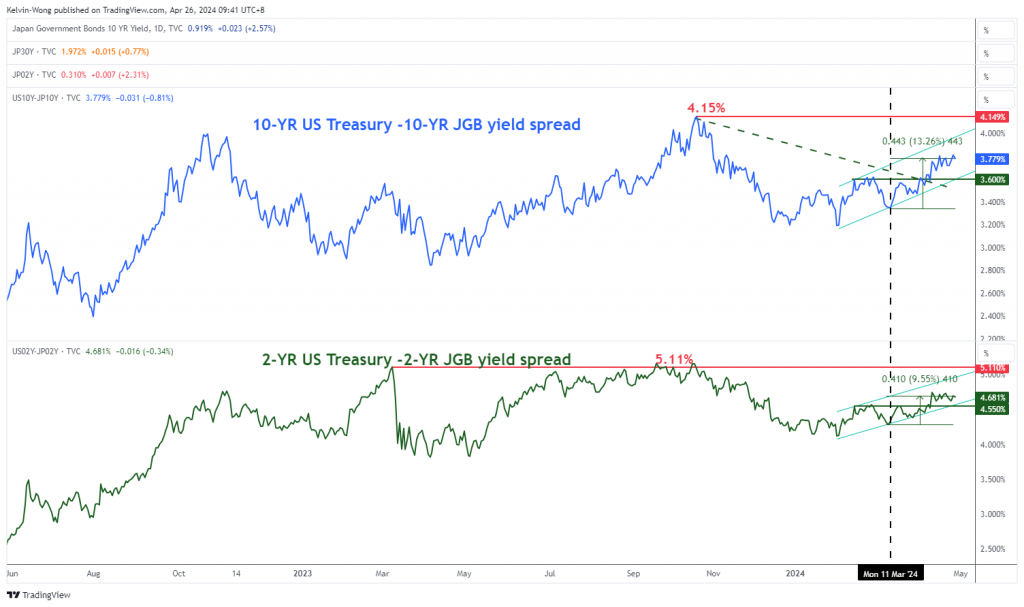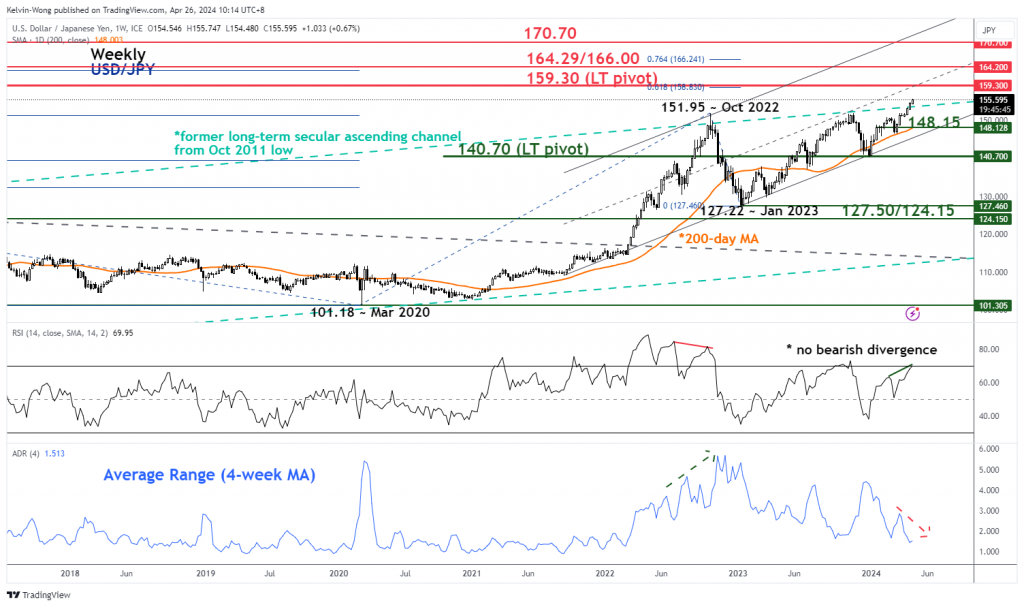- Tokyo’s core-core inflation for April came in at 1.8% y/y, its slowest pace of increase since September 2022 & below BoJ’s inflation target of 2%.
- The latest set of softer-than-expected Tokyo’s CPI may push back the timing of the next BoJ’s interest rate hike.
- Widening of US Treasuries-JGBs yield spread premium is likely to support a further potential upmove in the USD/JPY.
- The current upmove in USD/JPY since mid-March 2024 has been accompanied by a lower volatility condition versus its more abrupt rallies seen from July 2022 to September 2022 that triggered the actual FX intervention from MoF in October 2022.
This is a follow-up analysis of our prior report, “USD/JPY Technical: Rising US Treasury-JGB yield spreads outweigh BoJ’s intervention risk” published on 11 April 2024. Click here for a recap.
The price actions of USD/JPY have continued their relentless upward climb and breached above the 155.00 psychology level on Wednesday, 24 April, and cleared above the prior June 1990 swing high of 155.10. The US dollar added gains of +0.2% against the JPY by the end of yesterday, 25 April US session to hit a new 52-week high of 155.75.
So far, the USD/JPY has rallied by around +660 pips (+4.4%) from the historical Bank of Japan’s (BoJ) monetary policy decision on 19 March 2024 to end its eight years of short-term negative interest rate policy, hiked its overnight call interest rate to 0-0.1% for the first time in 17 years and scrapped the 10-year Japanese Government Bond (JGB) yield curve control program.
In today’s early Asian session, the USD/JPY traded sideways in a tight range of 10 pips as market participants wait for the latest monetary policy decision and economic outlook report release from BoJ at around 0300 GMT today.
The consensus expects no change to the overnight call policy interest rate and a slight upward revision to its median projected core-core (excluding fresh food and energy) inflation in Japan to 2% y/y from 1.9% y/y for fiscal years 2024 and 2025.
Timing of the next BoJ’s hike clouded by soft Tokyo’s core-core CPI
However, the timing of the next BoJ’s interest rate hike may get a bit “complicated” as the latest Tokyo inflation data for April (out earlier today) slowed down from the previous month and came in below expectations. Tokyo’s core-core inflation rate (excluding fresh food and energy) inched lower to 1.8% y/y in April from 2.9% y/y printed in March, below the consensus of 2.7% y/y, its slowest pace of increase since September 2022.
It is considered a big surprise that Tokyo’s core-core inflationary trend, often cited as a leading indicator of the Japan nationwide CPI has slipped below BoJ’s inflation target of 2%, where officials in the past two months have expressed “high confidence” that Japan economy has managed to exit from its decade-plus of deflationary spiral environment with stable inflationary growth at around 2% going forward.
Hence, BoJ Governor Ueda’s press conference later today after the close of the Japan stock market session will likely be pivotal as he is likely to be “quizzed” on whether the soft Tokyo CPI print is the start of a new trend or just an outlier. His guidance on how confident BoJ’s view on Japan’s inflationary trend in light of this new set of data might shed light on whether this July is still “live” for the next BoJ’s interest rate hike.
Intervention to strengthen the JPY may be ineffective at this juncture
Fig 1: US Treasuries/JGB yield spreads medium-term trends as of 26 Apr 2024 (Source: TradingView, click to enlarge chart)
In the past two weeks, there has been a slew of verbal interventions from Japan’s Ministry of Finance officials to talk down the US dollar strength as the USD/JPY has cleared above the prior 151.95 level where Japan authorities enacted an actual FX intervention on 21 October 2022, and spent close to US$60 billion to sell the US dollar against the JPY.
During that point in time in late October 2022, the pace of the increase of US Treasuries yields started to slow down which reduced its yield premium over JGBs yields. Hence, it reinforced the effectiveness of Japan’s FX intervention to drive down the USD/JPY by -16% in three months to hit a low of 127.22 on 16 January 2023.
In the current context, even though the yields of the JGBs have increased significantly since the last BoJ monetary policy meeting in March where the 2-year JGB yield rocketed to 0.3% at this time of the writing, a 34-yer high from close to 0% at the start of the year.
However, US Treasury yields rose at a faster pace than JGB yields due to a much stickier and elevated inflationary trend in the US that evaporated the earlier highly anticipated Fed dovish pivot narrative embraced by market participants at the start of 2024.
The yield spread premium between the 2-year and 10-year US Treasuries over JGBs has further widened by around 40 basis points (bps) since 11 March 2024 which in turn supports a weaker JPY over the US dollar (see Fig 1).
Lower volatility movement of USD/JPY in the past 5 weeks
Fig 2: USD/JPY major trend as of 26 Apr 2024 (Source: TradingView, click to enlarge chart)
The recent verbal interventions from Japanese MoF officials have centred on the monitoring of volatility movement in the FX markets for any form of “undesirable movements which implied that actual intervention might take form if movements of USD/JPY become abrupt.
Interestingly, the upmove of USD/JPY from the week of 11 March 2024 has been accompanied by a relatively lower volatility condition measured by a 4-week moving average of its weekly range (highest and lowest price points).
In contrast, the 4-week weekly range of USD/JPY increased significantly during the period from July 2022 to September 2022 before the actual FX intervention occurred in October 2022 (see Fig 2).
Therefore, MoF may not intervene in the FX market given such a lower volatility condition that has accompanied the current major uptrending phase of USD/JPY.
Content is for general information purposes only. It is not investment advice or a solution to buy or sell securities. Opinions are the authors; not necessarily that of OANDA Business Information & Services, Inc. or any of its affiliates, subsidiaries, officers or directors. If you would like to reproduce or redistribute any of the content found on MarketPulse, an award winning forex, commodities and global indices analysis and news site service produced by OANDA Business Information & Services, Inc., please access the RSS feed or contact us at info@marketpulse.com. Visit https://www.marketpulse.com/ to find out more about the beat of the global markets. © 2023 OANDA Business Information & Services Inc.




